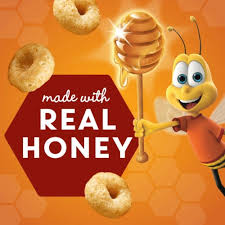The Birth of a Breakfast Icon
Honey Nut Cheerios is more than just a breakfast cereal—it’s a cultural staple that has graced American tables for decades. Launched in 1979 by General Mills, Honey Nut Cheerios was introduced as a sweeter alternative to the original plain Cheerios, which had been around since 1941. With the perfect blend of whole grain oats, a touch of honey, and the mild flavor of almonds (now often simulated), it was an instant hit among families looking for a delicious and convenient morning meal. Its iconic honeybee mascot, BuzzBee, quickly became one of the most recognizable cereal characters in American advertising, charming both kids and adults alike. From colorful commercials to creative box designs, Honey Nut Cheerios built an emotional connection with consumers that transcended just breakfast—it became part of the family routine.
Behind its success lies a smart marketing approach. General Mills positioned Honey Nut Cheerios not just as a tasty cereal but as a heart-healthy option. As public awareness about cholesterol and heart disease began to grow in the late 20th century, Honey Nut Cheerios seized the opportunity to highlight its use of whole grain oats and soluble fiber—both known to help lower cholesterol. The brand cleverly tapped into the health movement without sacrificing flavor, making it one of the rare cereals to straddle both the “treat” and “wellness” categories. Its promise was simple yet powerful: something sweet that’s also good for your heart. This dual appeal helped it become one of the best-selling cereals in America for decades, even topping the charts for several years in the 2010s.
What Makes Honey Nut Cheerios So Popular?
The widespread love for Honey Nut Cheerios isn’t accidental—it’s rooted in a combination of factors that perfectly meet the needs of modern consumers. First and foremost, the taste. The cereal offers a comforting sweetness without being overpowering. The light coating of honey and sugar creates a satisfying flavor that both kids and adults crave. Unlike sugar-bomb cereals that crash your energy levels mid-morning, Honey Nut Cheerios hits the right balance between flavor and function. That golden glaze adds just enough indulgence to whole grain oats, turning a basic ingredient into a delicious treat.
Then there’s the texture. Crisp when dry and just soft enough in milk, Honey Nut Cheerios maintain a satisfying bite. This makes them ideal not only for breakfast but also for snacking. In fact, many parents carry small containers of dry Cheerios as snacks for toddlers, making it a multi-purpose product in American households. The cereal is also gluten-free and contains no artificial flavors or colors, a big plus for the health-conscious shopper. With growing dietary restrictions and clean-label demands, Honey Nut Cheerios has stayed relevant by adapting to modern food trends without losing its original appeal. Moreover, its affordability, long shelf life, and wide availability in grocery stores make it a pantry essential. Whether you’re a college student, busy parent, or senior citizen, there’s a good chance you’ve enjoyed a bowl of Honey Nut Cheerios at some point.
Health Claims and the Heart-Healthy Debate
One of the most powerful associations with Honey Nut Cheerios is its heart-health branding. The cereal is often marketed as being capable of helping to lower cholesterol when eaten as part of a healthy diet. This claim is based on the beta-glucan found in oats—a soluble fiber that has been clinically shown to reduce LDL (bad) cholesterol levels. General Mills has leaned heavily on this claim, even adding a heart-shaped bowl and red-themed packaging to further emphasize its health benefits. Many boxes carry the famous tagline: “Can Help Lower Cholesterol as Part of a Heart-Healthy Diet.” And it’s not just marketing—several studies support the claim that oat-based cereals like Cheerios can contribute to better cardiovascular health.
However, the health claims haven’t come without scrutiny. Nutritionists and health experts have pointed out that while the oats are indeed beneficial, Honey Nut Cheerios still contains added sugars—about 12 grams per serving, which is higher than many assume for a “healthy” cereal. Some critics argue that the sugar content, especially for children consuming multiple servings, offsets some of the health benefits. Additionally, the use of processed ingredients, flavor enhancers, and genetically modified corn syrup has raised concerns among certain dietary groups. Still, in comparison to other sugary cereals, Honey Nut Cheerios is considered a “better-for-you” option—especially when paired with fresh fruit and low-fat milk. The debate essentially boils down to balance: it’s a healthy option, but like anything, it should be consumed mindfully.
Cultural Impact and the Future of the Brand
Honey Nut Cheerios is not just a breakfast item—it’s a piece of American cultural heritage. Over the years, the brand has partnered with various health organizations, including the American Heart Association, and participated in numerous awareness campaigns about heart disease. It has also been part of various social causes, including bee conservation efforts tied in with its BuzzBee mascot. From TV commercials during Saturday morning cartoons to nostalgic ads during Super Bowl Sunday, Honey Nut Cheerios has created a lasting presence in the lives of generations. It’s one of those rare products that feels both modern and timeless—comfort food that spans across age groups.
Looking ahead, the future of Honey Nut Cheerios seems secure but evolving. With younger generations leaning into plant-based, low-sugar, and clean-label trends, General Mills is experimenting with variations like Honey Nut Cheerios Medley Crunch and Protein Cheerios, as well as smaller packaging for on-the-go lifestyles. The brand also launched limited-time flavors and seasonal themes to keep the product line exciting. As food preferences continue to shift toward transparency and nutrition, Honey Nut Cheerios must balance its legacy with innovation. But if history is any guide, this iconic cereal will continue to adapt without losing the qualities that made it great—a simple, sweet, and heart-smart choice for everyday life.
SEO Keywords for Blog Optimization:
Honey Nut Cheerios, Honey Nut Cheerios heart health, best cereal for cholesterol, General Mills Cheerios, Buzz the Bee cereal, is Honey Nut Cheerios healthy, Honey Nut Cheerios nutrition facts, gluten free cereals, popular American breakfast cereals, best selling cereals in USA
Would you like me to also generate a cover image or infographic for this article? I can also format this for WordPress or Blogger if you need.

